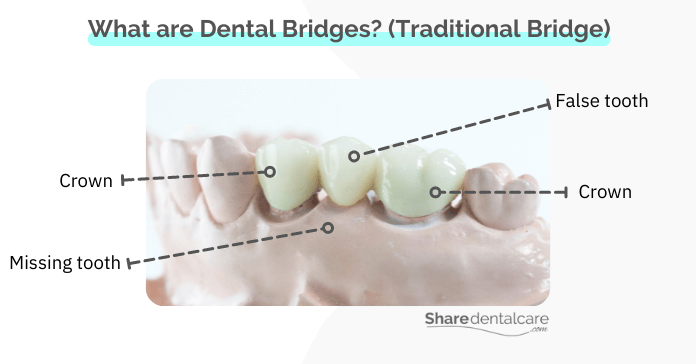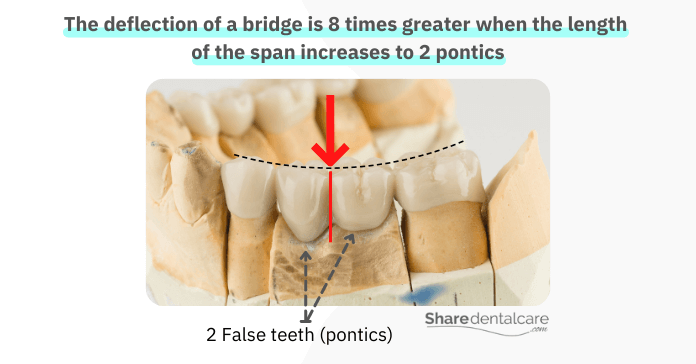Dental bridges are a good option for replacing a missing tooth or teeth. They are strong, durable, and can last for 15 years, even a lifetime when maintained properly. However, dental bridges are not indestructible. They may break or fracture over time, which can be frustrating for dental patients, especially if they don’t know why their dental bridge broke in half.
What are Dental Bridges?
You should know how dental bridges work to understand how & why your bridge broke in half. A dental bridge is a dental restoration that replaces a missing tooth or teeth. It consists of two crowns and a false tooth (pontic) in between. The false tooth fills the missing tooth gap, and the crowns are cemented onto the neighboring natural teeth to support the bridge.
When you chew on the false tooth, the force transfers from the dental bridge to neighboring natural teeth. High chewing forces can crack, break, or make your bridge lose. Learn more about the different bridge types in dentistry.

My Dental Bridge Broke in Half, Why?
Dental bridges are strong and durable, but they can break for several reasons. Here are some possible reasons why your dental bridge cracked or broke in half:
- Long missing teeth gap: the longer the gap, the more false teeth used, the greater the deflection & stress on the dental bridge. The deflection of the dental bridge could be the cause that broke your bridge in half. Compared to a single false tooth, the deflection is 8 times greater with 2 false teeth and 27 times greater with 3 false teeth. The longer the gap of missing teeth, the greater the deflection of the dental bridge.
- Teeth grinding & clenching: they could make your dental bridge weak & prone to breakage.
- Poor oral habits: habits like chewing on a pen or opening soda cans with your teeth can break and fracture your dental bridge.
- Improper dental hygiene: natural teeth that support the bridge are susceptible to tooth decay and periodontal disease, which can reduce the stability of the bridge and make it break easily.
- Injury: falling on an object or getting hit in the face can break the dental bridge.
- Wrong Bridge Type: types such as cantilever and Maryland bridges are not suitable for back teeth and places with high chewing force.
- Laboratory errors in the fabrication: this may occur due to some mistakes during the fabrication, such as low bridge thickness, poor dental material selection, or wrong fabrication technique, which can affect the longevity of the dental bridge.

What To Do If My Bridge Broke in Half?
If your dental bridge broke or fractured in half, you will need to contact your dentist as soon as possible. At the dental office, your dentist will remove the broken bridge and try to identify the causes of the breakage. Dental bridges that broke in half can’t be repaired and need to be replaced. So, your dentist will take an impression to make a new one. Also, they may make a temporary bridge to replace your broken bridge while the dental lab is making the permanent one.
What are Other Treatment Options If My Bridge Broke In Half?
First, you have to know why your bridge broke in half to prevent this from occurring again. For example, if your dental bridge failed because of years of dental neglect, then regular dental checkups and professional teeth cleaning will help prevent another failure. These are alternative treatments when a dental bridge breaks in half:
- Dental Implants: if you have 3 or more missing teeth on one side, it is recommended to use implants to support the bridge. This will reduce the deflection and stress on the restoration.
- Solid zirconia bridges: they are stronger than porcelain-fused-to-metal dental bridges and suitable for patients with teeth grinding.
- Traditional bridges: use the traditional design of fake tooth bridge to replace missing teeth and in places with high chewing force.
Caring for Your New Dental Bridge
There are some dental care tips to ensure your dental bridge lasts a long time.
- Maintain dental hygiene: dental bridges need proper dental care to make them last longer. Brush your teeth, floss, and use dental products such as mouthwash and fluoride toothpaste to keep your oral health good and protect the dental bridge from decay.
- Nightguard: if you have teeth-grinding, it is recommended to use a nightguard that will protect your bridge.
- Avoid dental injuries: falling on an object or getting hit in the face can break your dental bridge. So, use a mouthguard when playing sports, doing exercise, or working with heavy equipment that could injure you.
- Make regular dental visits: regular checkups are important for oral health. So, visit the dentist at least once in 6 months to avoid dental disease.
Dental Bridge Broke in Half – Conclusion
If your dental bridge broke or fractured in half, it is recommended to contact your dentist as soon as possible. Your dentist will remove the broken bridge and try to identify why it broke. Several factors can affect the longevity of dental restorations such as teeth grinding or clenching, poor oral hygiene, or injury. To prevent this problem again in the future, maintain good oral health with regular checkups at least once every six months and avoid accidents by using a mouthguard while playing sports or working with heavy equipment.